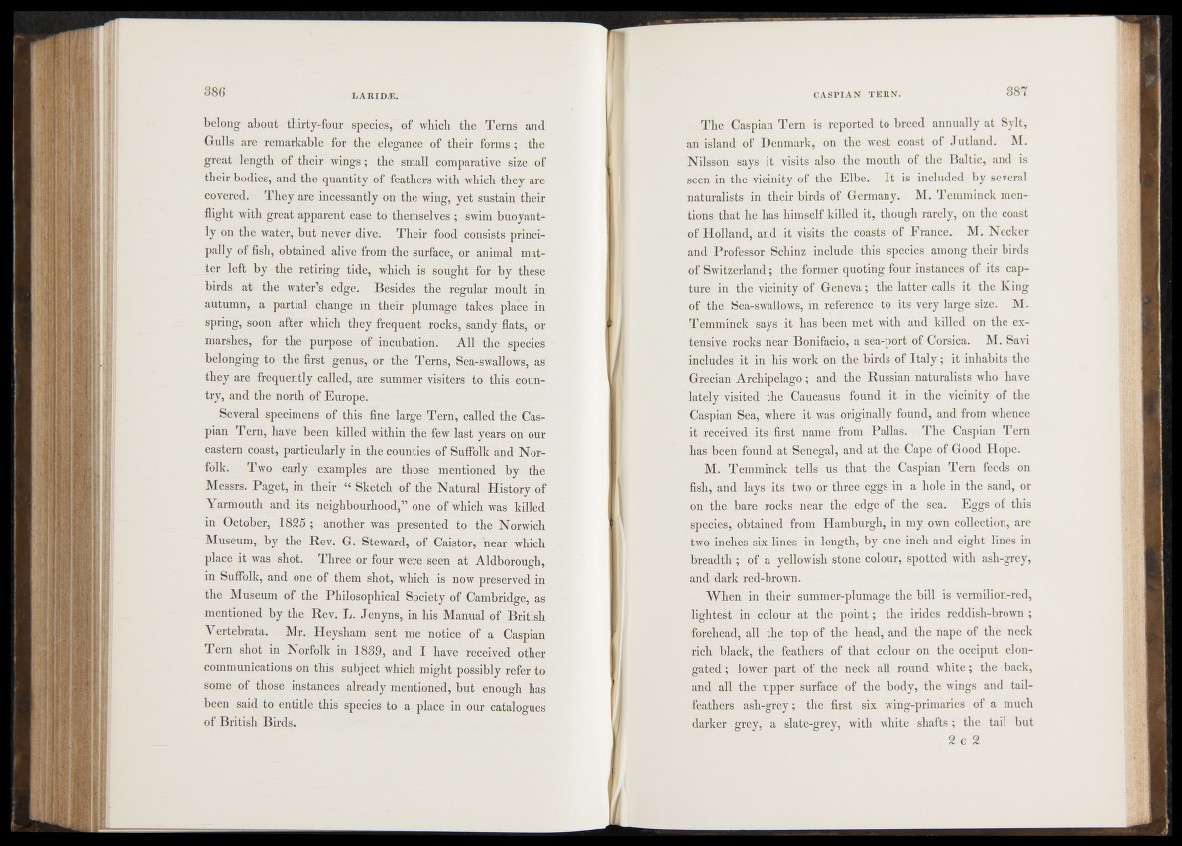
belong about thirty-four species,p o f which the Terns and
Gulls are remarkable for the elegance of their forms; the
great length of their wings; the small comparative »size; of
their bodies, and the quantity of feathers with which they are
covered. They are incessantly on the wing, yet sustain their
flight with great apparent ease to themselves ;. swim buoyantly
on the water, but never dive. . Their food-nmpists principally
of fish, obtained aliyéÉfrom -the surface, or animal matter
left by the retiring tide, which is sought for by these
birds a t the water’s edge.. Besides the regular moult in
autumn, a partial change in their plumage takes place in
spring, soon after which they frequent rocks, sandy flats, or
marshes, for the purpose o f incubation. All the species
belonging to the first genus, or the« Tern's, Sea-swaMows, as
they are frequently called, are summer visiters to this country,
and the north of Europe.'
Several specimens of this fine large Tertf, called the Caspian
Tern, have been killed within therfew last years on our
eastern coast, particularly in the counties *of Suffolk and Norfolk.
Two early examples Sre those mentioned by the
Messrs. Paget, in their “ Sketch, b f the Natural - Uisto%tbf
Yarmouth and its neighbourhood,” one of which was killed
in October, 1825; another was presented to the Norwich
Museum, by the Rev. G. Steward, of Caistor, hear which
place it was shot. Three or four, were seen at Aldborouuh,
in Suffolk, and one of them shot, which . is?£now preserved in
the Museum of the Philosophical Society of Cambridge, as
mentioned by the Rev. L. Jenyns, in has Manual of British
Vertebrata. Mr. Heysham sent me notice of a Caspian
Tern shot in Norfolk in 1839, and I have received other
comm unications on this subject which might possibly refer to
some of those .instances already mentioned, but enough has
been said to entitle this species to a place in our catalogues
of British Birds.
The Caspian Tern is reported to breed annually at Sylt,
an island of Denmark, on the west coast of Jutland. M.
Nilsson says I it visits also the mouth of the Baltic, and is
seen in the vicinity of the Elbe. I t is included by several
naturalists in their birds of Germany. M. Temminck mentions
that he has himself killed it, though rarely, on the coast
of Holland, and it visits -the coasts of France. M. Necker
and Professor Schinz include this spècies among their birds
of Switzerland; theffqrmer quoting Jour instances of its capture
in the.vicinity of Geneva; the latter calls it the King
of the Sea-swallows; in reference to. its very large size. M.
Temminck says-4 t? has been* met with and killed' on the extensive
rocks near Bonifacio,,a sea-port of Corsica. M. Savi
includes dt in his work on the birds of Ita ly ; it "inhabits the
Grecian Archipelago; and the Russian naturalists who have
lately visited the Caucasus {found it in the vicinity of the
-Caspian Sea, whére it-was originally, found, and from whence
-ifereceived-its first name from Pallas. The Caspian Tern
hais beeh'found at Senegal, and at thé Cape of-Good Hope.
M. Temminck tells us that the Caspian Tern feeds on
fish, and: lays* its two or three eggs in a hole in the sand, or
on1: tlfo$ bare- -rocks near the edge of the sea. Eggs of this
species-;: obtained from Hamburgh, in my own collection, are
two inches six lines in length, by one inch and eight lines in
breadth >;Vof a yellowish stone colour, spotted with ash-grey,
and dark red-brown.
When in their summer-plumage the bill is vermilion-red,
lightest in colour at the point; the irides reddish-brown;
forehead, all :the top of the head, and the nape of the neck
rich black, the feathers of that feolour on the occiput elongated;
lower part of the neck all round white; the back,
and all the upper surface of the body, the wings and tail-
feathers ash-grey; tlie first six wing-primaries of a much
darker grey, a slate-grey, with white shafts; the tail but
2 c 2